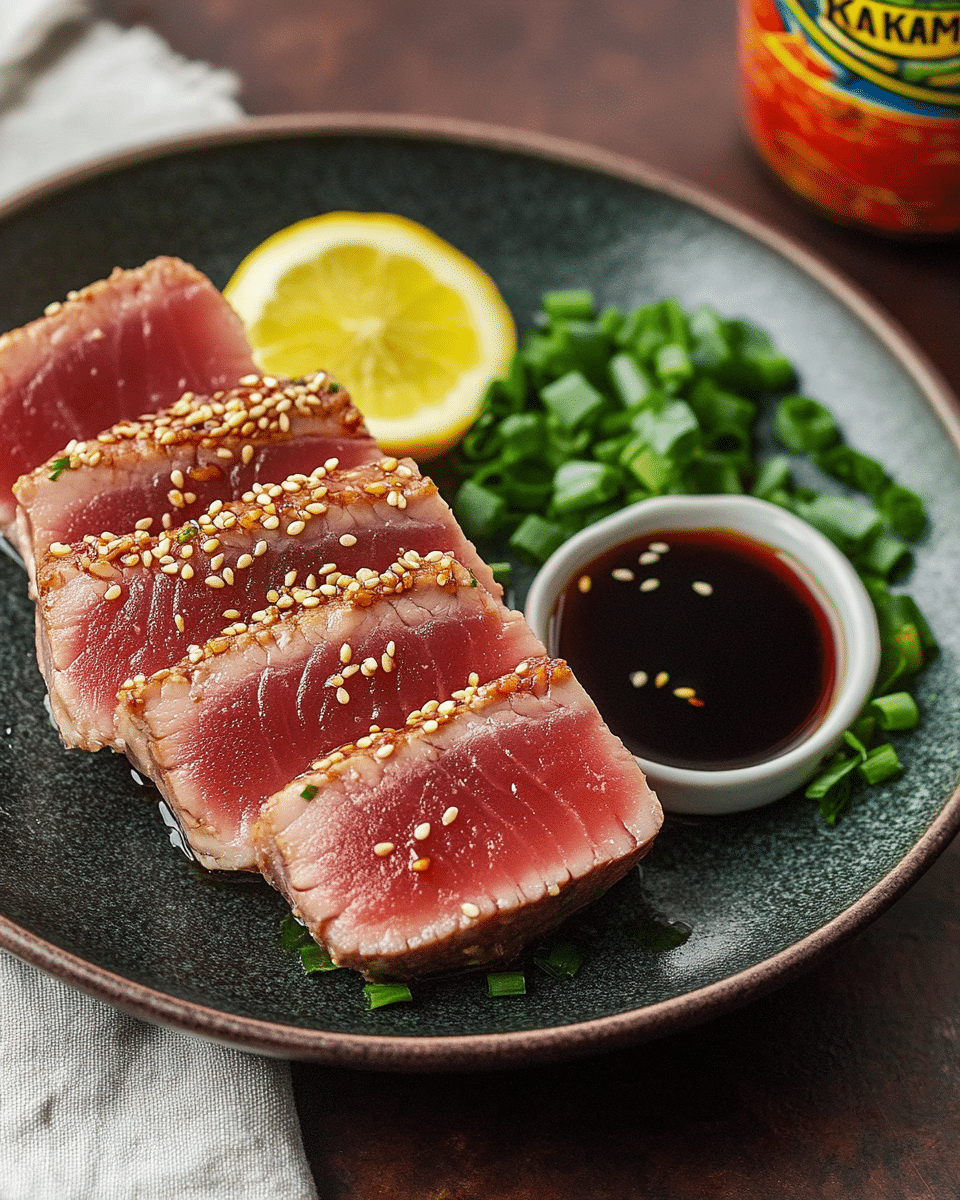Seared Ahi Tuna with Ponzu Dipping Sauce is a dish that strikes a perfect balance between simplicity and sophistication. The fresh, ruby-red tuna is quickly seared to perfection, leaving the inside tender and rare, while the outer edges gain a slight, savory crust. The delicate flavor of the tuna pairs harmoniously with the vibrant, tangy notes of the Ponzu dipping sauce made from soy, citrus, and aromatic ginger, providing a refreshing contrast that elevates the dish to a restaurant-quality experience.
Ideal for a light dinner, an appetizer for a dinner party, or even as part of a sushi-inspired spread, this recipe showcases the beauty of high-quality, fresh seafood with minimal effort. Each bite delivers a satisfying combination of textures and flavors, the silky tenderness of the tuna, the crunch of toasted sesame seeds, and the umami punch from the Ponzu. Whether you are a seasoned seafood lover or a curious beginner in Japanese-inspired cooking, this dish is bound to impress.
Full Recipe:
Ingredients:
-
4 fresh ahi tuna steaks (about 6 oz each)
-
2 tablespoons Kikkoman Ponzu Sauce
-
2 tablespoons Kikkoman Soy Sauce
-
1 tablespoon sesame oil
-
1 tablespoon vegetable oil
-
1 tablespoon fresh lemon juice
-
1 teaspoon grated fresh ginger
-
2 green onions, thinly sliced
-
1 tablespoon toasted sesame seeds
-
Freshly ground black pepper, to taste
Directions:
-
In a small bowl, mix together Kikkoman Ponzu Sauce, Kikkoman Soy Sauce, sesame oil, lemon juice, ginger, and green onions. Set aside for dipping.
-
Season the tuna steaks with freshly ground black pepper on both sides.
-
Heat vegetable oil in a skillet over medium-high heat until hot.
-
Sear each tuna steak for about 30 seconds to 1 minute on each side, depending on desired doneness (rare to medium-rare is recommended).
-
Remove the tuna steaks from the skillet and let rest for 1-2 minutes.
-
Slice the tuna into thin strips.
-
Sprinkle with toasted sesame seeds and serve immediately with the Ponzu dipping sauce.
Prep Time: 10 minutes | Cooking Time: 3 minutes | Total Time: 13 minutes
Kcal: 230 kcal | Servings: 4 servings
Seared Tuna with Ponzu Dipping Sauce: A Gourmet Delight in Every Bite
When it comes to seafood that is both quick to prepare and rich in flavor, Seared Tuna with Ponzu Dipping Sauce stands tall as a crowd favorite. This dish is the epitome of simplicity meeting elegance, where premium quality ahi tuna is seared to perfection and paired with a tangy, umami-rich ponzu dipping sauce. It’s the perfect solution for a light dinner, an impressive appetizer, or even a centerpiece in a Japanese-inspired meal spread.
Tuna, especially the prized ahi variety, is renowned for its delicate flavor, buttery texture, and high protein content. While raw tuna has its place in sushi and sashimi, lightly searing the tuna locks in its natural juices and enhances the outer layers with a savory crust, offering the best of both worlds, cooked and raw. This contrast in textures makes seared tuna a true delicacy among seafood lovers.
The Star of the Show: Ahi Tuna
Ahi tuna, also known as yellowfin tuna, is prized in global culinary circles for its firm texture and clean, meaty flavor. Ahi tuna fillets are typically a bright ruby red, indicating their freshness. When buying tuna for this recipe, it is crucial to select sushi-grade or sashimi-grade tuna, which ensures that the fish is fresh enough to be consumed raw or lightly seared.
Tuna is an excellent source of high-quality protein and is low in fat, making it a favorite among health-conscious individuals and athletes. It also boasts a rich profile of omega-3 fatty acids, which are essential for heart health, brain function, and reducing inflammation. The minimal cooking involved in searing helps retain these vital nutrients, making this dish as nutritious as it is flavorful.
The Role of Ponzu: A Symphony of Flavors
Ponzu sauce is a classic Japanese condiment made from a harmonious blend of soy sauce, citrus juice (often yuzu or lemon), rice vinegar, and sometimes a touch of mirin or dashi. The result is a bright, tangy, and slightly sweet sauce that pairs beautifully with the rich, savory notes of seared tuna.
The acidity in ponzu helps to balance the fattiness of the tuna, while the salty soy sauce and umami undertones deepen the flavor complexity. It acts not just as a dipping sauce, but as a flavor enhancer that lifts the dish to gourmet status without overpowering the natural taste of the tuna.
Why Seared Tuna is a Must-Try Dish
1. Quick and Effortless Preparation
Seared tuna is one of the quickest seafood dishes you can make. From start to finish, the entire preparation takes less than 15 minutes, making it ideal for busy weeknights or when unexpected guests arrive. It requires minimal ingredients and can be customized with a variety of seasonings like black pepper, sesame seeds, or even chili flakes for a spicy kick.
2. Healthy and Nutritious
This dish is perfect for those who want to enjoy a light, low-carb, high-protein meal without sacrificing flavor. As mentioned earlier, tuna is a lean source of protein packed with essential omega-3 fatty acids. The use of sesame oil and a soy-based ponzu sauce keeps the fat content in check while adding depth to the dish.
3. A Culinary Canvas for Creativity
Seared tuna is incredibly versatile. You can serve it as a main dish alongside steamed jasmine rice or fresh greens. Alternatively, slice it thinly and present it as an appetizer paired with pickled ginger, wasabi, or a fresh seaweed salad. Some even enjoy it in poke bowls, adding diced mango, avocado, and cucumber for a Hawaiian twist.
4. Visually Stunning Presentation
The striking contrast between the seared edges and the rare, ruby-colored center of the tuna makes this dish as beautiful as it is tasty. When sliced and fanned out on a serving platter, seared tuna becomes an eye-catching centerpiece that elevates any meal setting.
Tips for Perfect Seared Tuna Every Time
-
Start with quality tuna: Always use sushi-grade tuna to ensure safety and the best taste.
-
Pat the tuna dry: Removing moisture from the tuna’s surface helps achieve a perfect sear.
-
Don’t overcook: A quick sear, usually 30 seconds to 1 minute per side is all you need. Overcooking will result in dry, flavorless tuna.
-
Use a hot pan: The skillet should be smoking hot to create a caramelized crust without cooking the interior.
-
Season thoughtfully: Tuna doesn’t need much seasoning; a touch of black pepper and sesame seeds is often enough.
Pairing Suggestions: Complete the Experience
For a well-rounded dining experience, consider serving Seared Tuna with Ponzu Dipping Sauce with the following:
-
Steamed Jasmine or Brown Rice: Keeps the meal simple and satisfying.
-
Cucumber Salad with Rice Vinegar Dressing: Adds a refreshing crunch that complements the tuna.
-
Miso Soup: A light and comforting starter that sets the stage for the main dish.
-
Chilled Sake or Dry White Wine: Both beverages pair beautifully with the subtle flavors of seared tuna.
Cultural Origins: A Taste of Japan
The art of searing tuna (tataki) originates from Japanese cuisine, where minimal cooking is often employed to highlight the natural taste and texture of fresh fish. The term “tataki” refers to the method of quickly searing fish or meat on the outside while leaving the inside rare or raw. This preparation method preserves the freshness of the fish while adding a smoky, savory element from the searing process.
Ponzu sauce, another Japanese staple, is beloved across the globe for its ability to add brightness and depth to everything from grilled meats to noodles and vegetables. In this recipe, the combination of seared tuna and ponzu captures the spirit of Japanese simplicity and balance where every ingredient plays a deliberate, harmonious role.
Sustainability Considerations
When purchasing tuna, it’s important to select fish that has been caught sustainably. Overfishing is a serious concern for tuna species, particularly yellowfin and bluefin. Look for certifications from organizations like the Marine Stewardship Council (MSC) or tuna labeled as “pole-and-line caught” or “FAD-free” to ensure that your meal supports responsible fishing practices.
Sustainable choices not only help protect marine ecosystems but also encourage responsible consumer habits that can shape the future of seafood availability.
Variations and Customizations
If you want to experiment, here are a few ways to tweak this recipe:
-
Spicy Tuna Tataki: Add a sprinkle of chili flakes or a dash of Sriracha to the ponzu sauce.
-
Garlic-Lover’s Version: Rub fresh minced garlic onto the tuna before searing for an extra punch.
-
Tuna Tacos: Slice the seared tuna thinly and layer into soft tortillas with cabbage slaw and a drizzle of ponzu mayo.
-
Tuna Poke Bowls: Dice the tuna after searing and serve over sushi rice with edamame, pickled ginger, and avocado slices.
Conclusion
Seared Tuna with Ponzu Dipping Sauce is a delightful dish that manages to be light, flavorful, and satisfying all at once. Its simplicity in preparation belies its rich taste and elegant presentation, making it suitable for both casual family dinners and sophisticated dinner parties. This recipe not only offers health benefits but also brings the essence of Japanese culinary finesse to your kitchen. With high-quality ingredients and a few expert techniques, anyone can create a dish that tastes as good as it looks.
Whether you’re a home cook trying something new or a seasoned foodie seeking a quick gourmet meal, this seared tuna dish promises to deliver satisfaction every time. Its versatility means you can enjoy it in various forms on its own, as part of a rice bowl, or even in tacos, ensuring it remains a favorite in your recipe rotation.
By choosing sustainable seafood and high-quality condiments like Kikkoman Ponzu, you contribute to a more responsible and delicious way of eating. So next time you’re in the mood for something light yet luxurious, reach for that ahi tuna and sizzle your way to a meal worth savoring.






